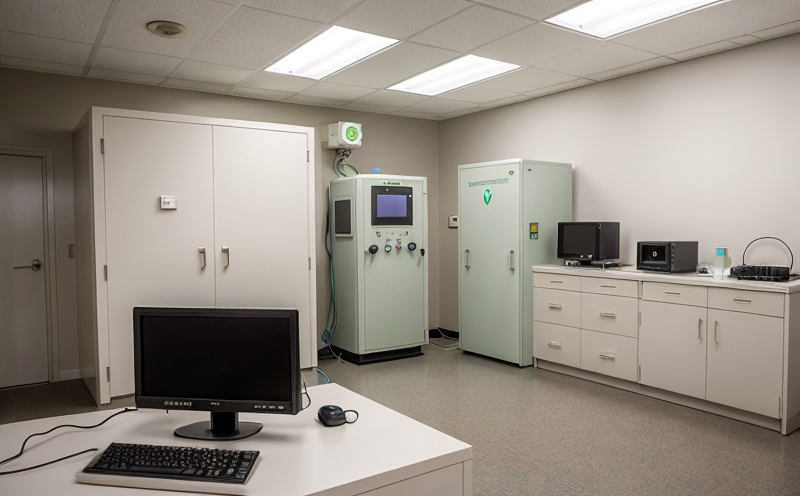ASTM E181 Standard Test for Detecting Ionizing Radiation by Film Badges
The ASTM E181 standard provides a method for detecting and measuring ionizing radiation using film badges. This testing process is crucial in environments where workers may be exposed to ionizing radiation, ensuring compliance with international safety standards.
Film badges are small, lightweight devices that contain a photographic emulsion layer sensitive to ionizing radiation. When worn by personnel, these badges accumulate exposure over time, which can then be developed and analyzed to quantify the absorbed dose of radiation. This method is widely used in industries such as nuclear power, healthcare, and manufacturing.
The ASTM E181 standard specifies detailed procedures for the preparation, calibration, placement, and analysis of film badges. It ensures consistent and accurate measurement across different laboratories and test facilities. The standard also outlines acceptable limits of exposure based on international safety guidelines, such as those provided by the International Commission on Radiation Protection (ICRP).
Preparation involves careful handling to avoid contamination or damage that could affect the accuracy of the results. Calibration ensures that the badges accurately measure radiation levels within specified tolerances. Placement is critical; badges should be worn in a manner consistent with expected exposure, which often includes specific areas on the body where radiation might accumulate.
Analysis involves developing the film badge and comparing the resulting image to reference standards or using densitometry techniques to quantify absorbed dose. This process requires specialized equipment capable of detecting minute changes in the emulsion layer due to ionizing radiation.
The standard also includes guidelines for reporting results, which are essential for compliance with occupational safety regulations. Reporting typically includes detailed information about the badge's placement, exposure conditions, and the calculated absorbed dose. Compliance officers can use these reports to monitor worker exposure and implement necessary safety measures.
ASTM E181 ensures that film badges meet rigorous quality standards, which is vital for accurate radiation monitoring. By adhering to this standard, laboratories provide reliable data that helps protect workers from potential health risks associated with ionizing radiation exposure.
To summarize, the ASTM E181 standard provides a robust framework for detecting and measuring ionizing radiation using film badges. This method is indispensable in ensuring worker safety and compliance with international safety standards.
Why It Matters
The ASTM E181 standard plays a crucial role in safeguarding the health of personnel working in environments where ionizing radiation exposure is possible. By accurately detecting and quantifying absorbed dose, this method helps prevent overexposure to radiation, which can lead to serious health issues such as cancer or genetic mutations.
Compliance with ASTM E181 ensures that workplaces meet international safety standards set by organizations like the ICRP. This not only protects workers but also enhances a company's reputation for being proactive in occupational safety and health.
- Reduces Health Risks: Accurate detection of ionizing radiation exposure helps prevent long-term health effects associated with overexposure.
- Ensures Regulatory Compliance: Adhering to ASTM E181 ensures that a facility meets the stringent requirements set by regulatory bodies.
- Promotes Worker Safety: Reliable data from film badges allows for timely implementation of safety measures and protocols.
The standard also contributes significantly to the development of safer work practices, which can lead to reduced insurance costs and lower liability risks. By maintaining a culture of compliance, companies demonstrate their commitment to worker well-being and environmental responsibility.
Quality and Reliability Assurance
ASTM E181 emphasizes the importance of quality assurance in film badge testing by outlining specific procedures for preparation, calibration, placement, and analysis. These steps ensure that the results are accurate and consistent, thereby enhancing reliability.
- Preparation: Careful handling to avoid contamination or damage is essential to maintain the integrity of the emulsion layer.
- Calibration: Ensures the badge accurately measures radiation levels within specified tolerances. Calibration is performed using known radiation sources and must be periodically checked for consistency.
- Placement: Proper positioning on the body ensures that the badge captures exposure data relevant to the specific work environment. Incorrect placement can lead to inaccurate readings, which could mislead safety protocols.
- Analysis: Involves developing the film and comparing it to reference standards or using densitometry techniques to quantify absorbed dose. This process requires precise equipment capable of detecting minute changes in the emulsion layer due to ionizing radiation.
The ASTM E181 standard also includes guidelines for reporting results, which are essential for compliance with occupational safety regulations. These reports provide detailed information about the badge's placement, exposure conditions, and the calculated absorbed dose. Reliable data from film badges allows for timely implementation of necessary safety measures and protocols.
By adhering to ASTM E181, laboratories ensure that their testing methods are consistent and accurate, thereby enhancing overall reliability. This consistency is crucial in maintaining a safe work environment and ensuring compliance with international safety standards.
Environmental and Sustainability Contributions
The ASTM E181 standard supports environmental sustainability by promoting the responsible use of ionizing radiation monitoring tools. By accurately detecting and quantifying absorbed dose, this method helps prevent overexposure to radiation, which can lead to significant health impacts on both workers and the environment.
- Reduces Exposure Risks: Accurate detection ensures that workers are not exposed to excessive levels of ionizing radiation, reducing the risk of long-term health effects.
- Informs Safety Protocols: Reliable data from film badges allows for timely implementation of safety measures and protocols, minimizing potential environmental impacts.
The standard also contributes to sustainability by encouraging the responsible use of resources. By ensuring that workers are not overexposed, companies can avoid costly medical treatments and support a healthier workforce, which is essential for long-term productivity and efficiency.
Furthermore, compliance with ASTM E181 helps reduce liability risks associated with occupational health issues. This proactive approach to safety and environmental stewardship enhances a company's reputation as a responsible corporate citizen.





